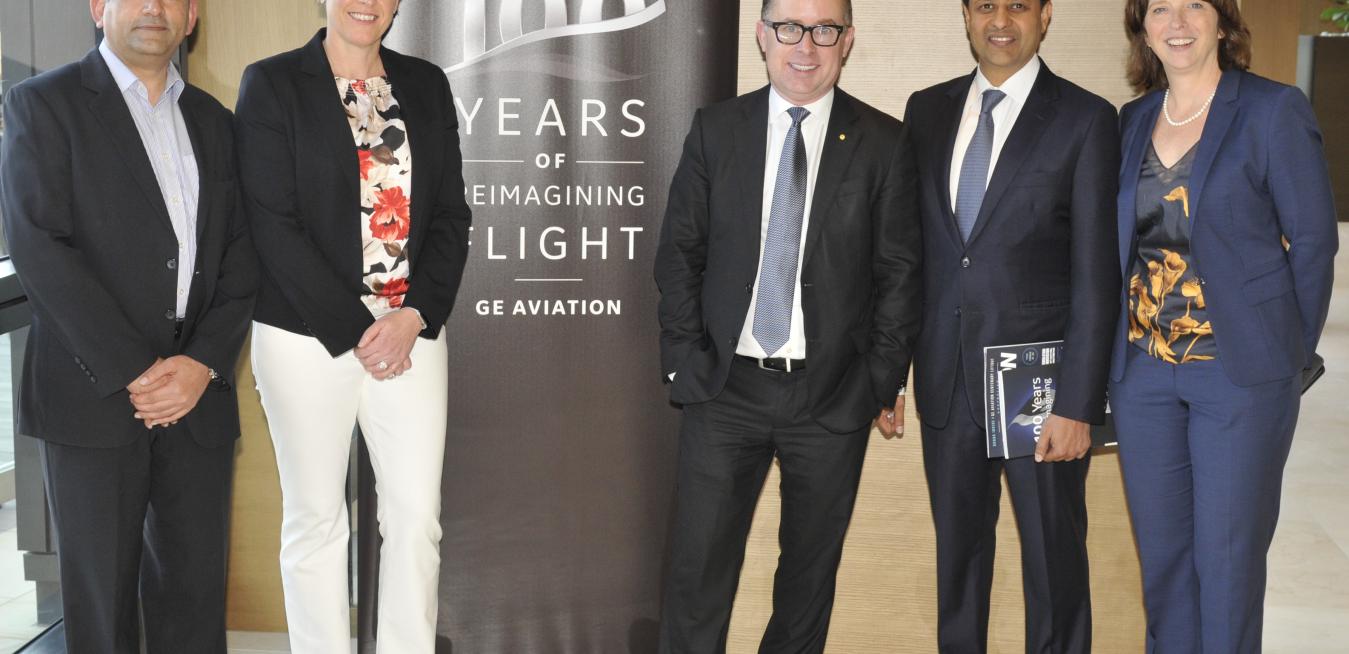At the GE Aviation 100th anniversary celebration at Sydney’s harbourside Park Hyatt Hotel, Qantas CEO Alan Joyce quipped to the crowd, “It’s great to be here and to be surrounded by so many of our friends ... and so many of our enemies as well!” The gathered glitterati of the Pacific region’s aviation industry laughed out loud as they basked in a collective sense of uplifting achievement.
Air New Zealand had just days before inked its order for eight Boeing 787-10 Dreamliners powered by GEnx-1B engines. The Qantas Group recently increased its order for CFM LEAP-1A-powered Airbus A320neo series aircraft to 109…
“One of the reasons I think the industry is so resilient,” said GE Aviation’s new VP of sales for APAC, Kathy MacKenzie, “is that people want to experience the world. And as more and more people come into the middle class, you have great airlines like Jetstar making that affordable.”
Air travel is also becoming more sustainable with every fuel-efficient innovation. The A321 XLR (extra long range), which accounts for 36 of Qantas’s latest Airbus order, delivers 30% lower fuel burn per seat compared with previous generation aircraft, thanks in large part to Qantas’s choice of CFM International LEAP-1A engines to power its A320neo fleet.
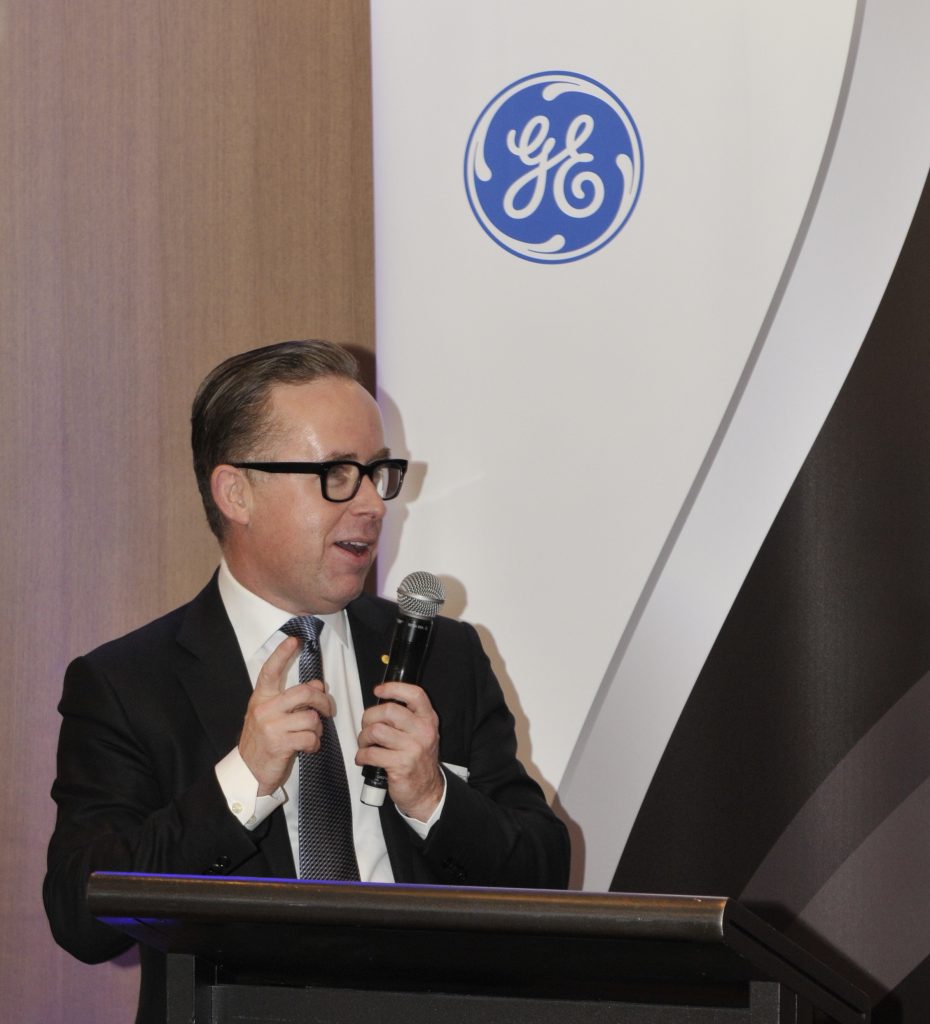 Alan Joyce, CEO and managing director of Qantas Airways, said in his address to the crowd: We’re learning a lot from this 100-year celebration. Next year Qantas gets to its 100-year celebration. The longevity of both organisations makes us very similar… it’s innovation that allows you to survive that length of time.”
Alan Joyce, CEO and managing director of Qantas Airways, said in his address to the crowd: We’re learning a lot from this 100-year celebration. Next year Qantas gets to its 100-year celebration. The longevity of both organisations makes us very similar… it’s innovation that allows you to survive that length of time.”LEAP engines, the latest product of the GE-Safran joint venture CFM, deliver 15% improvement in fuel consumption over today’s best CFM56 engines. Among the innovations of LEAP engineering is the use of additive manufacturing to “grow” complex parts such as fuel nozzles, which makes these parts stronger and more durable, yet lighter.
After the room had shown its competitive spirit in a hotly contested GE Aviation trivia quiz, Bill Osmond, head of group fleet planning for Qantas, said, “What gets me excited is that we’re addressing climate change.” He said aviation, and in particular airlines operating from one of the most geographically distant regions on the planet, have been “naturally incentivised to want to get to greater fuel efficiency, to fly further, take greater passenger loads, make travel accessible — to do that we had to bring the fuel consumption down.”
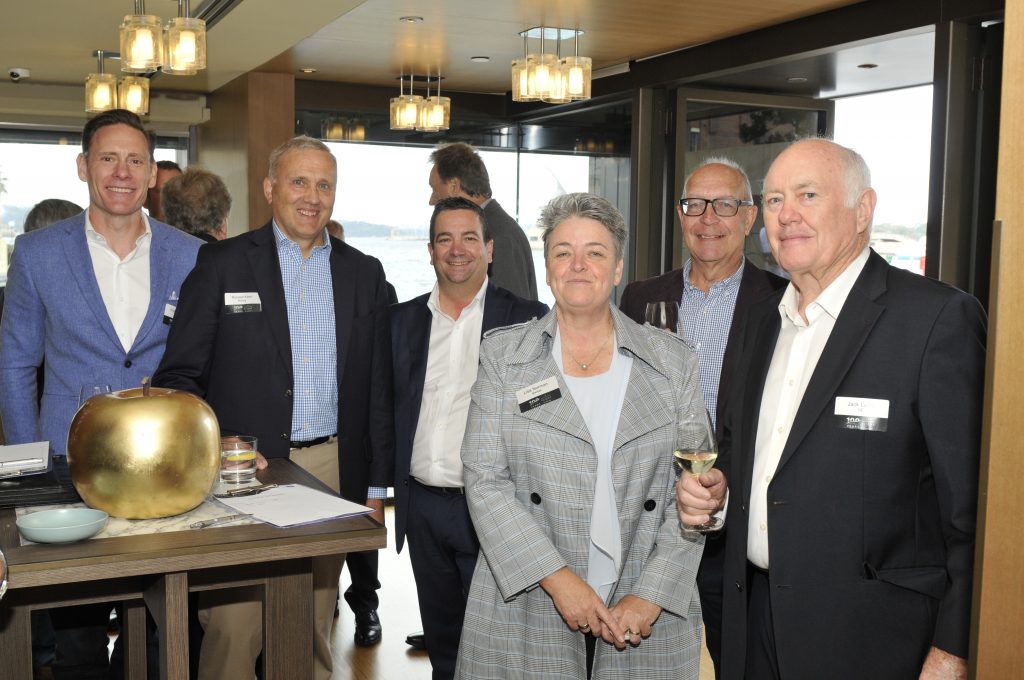 Among the guests (from left): Andrew Finch from Qantas; Boeing’s Ronald Kent; Bill Osmond and Lisa Norman from Qantas; David Forsyth, ex-Qantas, now retired; and legendary, now-retired GE Aviation sales director Jack Lutze. Lutze regaled colleagues with stories: "When I first started out they were building the CFM, and they said, if we can sell 1000 of these engines it’ll be a great engine. They’ve sold 30,000, and with the uninstalled it’s probably nearer 40,000," he said. "And I sold a couple of those aeroderivative engines into Kalgoorlie, to the miners there, because they were having a fight with the Electricity Commission of Western Australia, and refused to pay the charges. They wanted to make their own electricity, so we sold them two aeroderivative gas turbines.”
Among the guests (from left): Andrew Finch from Qantas; Boeing’s Ronald Kent; Bill Osmond and Lisa Norman from Qantas; David Forsyth, ex-Qantas, now retired; and legendary, now-retired GE Aviation sales director Jack Lutze. Lutze regaled colleagues with stories: "When I first started out they were building the CFM, and they said, if we can sell 1000 of these engines it’ll be a great engine. They’ve sold 30,000, and with the uninstalled it’s probably nearer 40,000," he said. "And I sold a couple of those aeroderivative engines into Kalgoorlie, to the miners there, because they were having a fight with the Electricity Commission of Western Australia, and refused to pay the charges. They wanted to make their own electricity, so we sold them two aeroderivative gas turbines.”The digital revolution
Alan Joyce and many of his Qantas team in the room also praised the success of the GE-Qantas-developed FlightPulse app, which puts flight and fuel analytics in the hands of some 2,500 individual Qantas pilots, and has helped the airline significantly reduce fuel burn and carbon emissions.
Captain Lisa Norman, who has been with Qantas for 30 years, said, “FlightPulse gives you more data, but it’s what you do with that data. It tells you all sorts of things from take-off to landing.” She said it has become an invaluable tool for pilot training. In the past trainer feedback to new pilots had been more subjective, Norman explained: “They might have said, ‘I think that was a bit fast’, or a bit slow.” Now she says, FlightPulse enables each pilot to see their performance and fuel burn for every component of the journey.
Norman famously flew the inaugural non-stop Perth-London flight in March 2018, with a Boeing 787-9 Dreamliner powered by two GEnx engines. Large sections of this Boeing aircraft are constructed from light carbon-fibre composites, the same material GE used to build the fan blades and the case for its jet engines. The aircraft’s design, computer systems, and engines combined reduce fuel consumption by 20% compared to planes of similar size, which can save Qantas and its airline peers operating the jets up to $1.6 million per plane per year in fuel expenses.
Joyce nominated the success of the 16-17-hour Perth-London route as a highlight of Qantas’s partnership with GE. The “entire world” watched that inaugural flight, he said, because Australia and Europe were “the only two continents without a direct link until that engine and that aircraft allowed us to do it.”
“Thanks to the innovation of Boeing and GE,” said Joyce, 18 months after seating the first passengers on QF 9, it’s already “one of the most reliable routes on the network”.
Qantas executives in the room were also excited about the future of travel in the Asia-Pacific, with Joyce saying that between 2020 and 2024 the introduction of more than 100 Airbus narrow-body A320s running on CFM LEAP-1A propulsion “will change travel in South East Asia; we’ve democratised travel in the region with Jetstar, and this aircraft will help us do more of that on longer routes.”
A quartet of aviation centenaries
Within a few years of one another, four titans of aviation in Australia will have popped the champagne corks on their 100 years in operation. Boeing touched down first in 2016, Qantas will mark its centenary in 2020. And the RAAF will put on an Air Show to the power of 100 in 2021.
Joyce notes that although Qantas and GE Aviation have both been around for 100 years, their flight paths didn’t become linked until the late ’80s. “Since then,” he says, “you look at how much of our fleet has GE engines — the 767s, the 747s, then it went on to the 737s, the A330s and now the 787. That trust has built up over the years and now the largest part of the Qantas main-line fleet by far is powered by GE.”
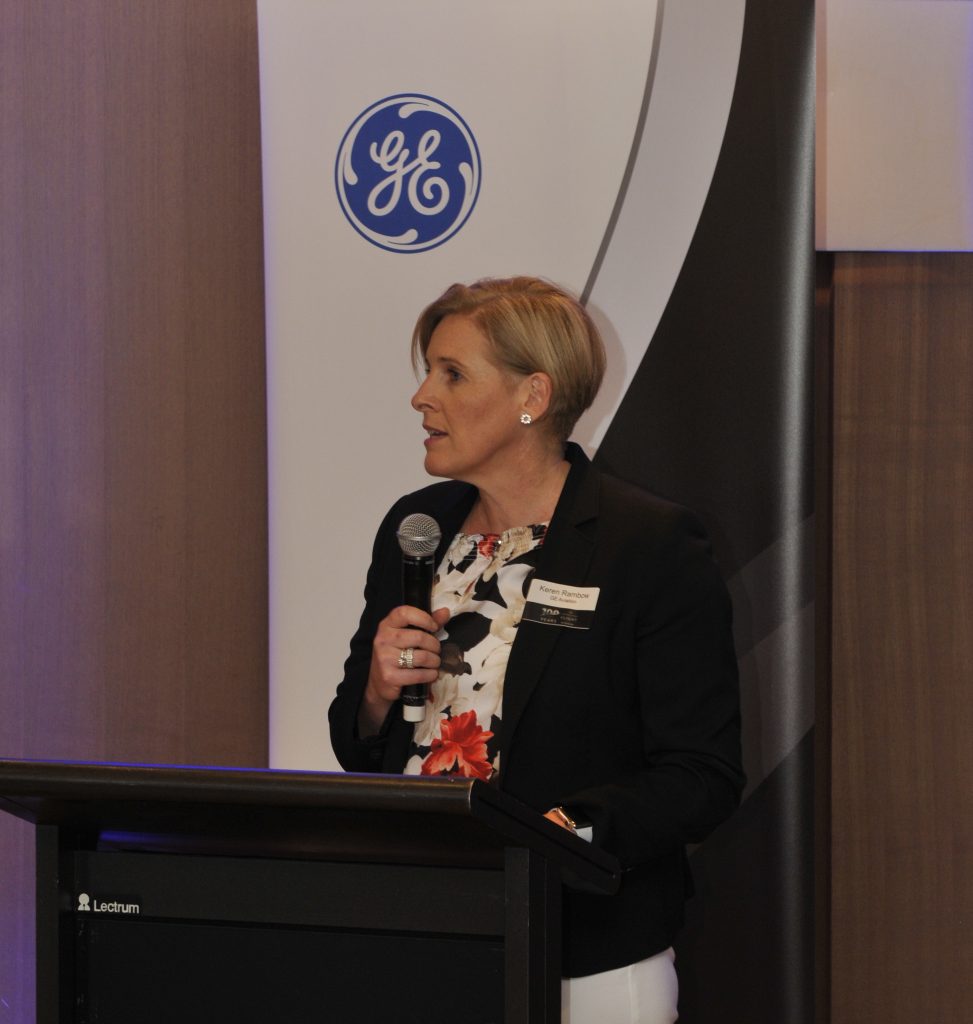 Keren Rambow, GE Aviation’s regional general manager of sales in the South Asia Pacific, hosted the Sydney celebration of 100 years of GE Aviation.
Keren Rambow, GE Aviation’s regional general manager of sales in the South Asia Pacific, hosted the Sydney celebration of 100 years of GE Aviation.Keren Rambow, GE Aviation’s head of sales in South Asia Pacific, emphasised in her opening of the centenary event that the relationships GE Aviation has with its airline customers in the region are unique. “Our staff go through the ups and downs with you, and their emotions are on the line with yours,” she said, acknowledging both the diligence and dedication of her teams, and the “humbling” trust that airlines place in them.
Supporting regional defence forces with speed, thrust and reliability
She also celebrated the longevity of GE Aviation’s relationship with Australian and New Zealand defence forces.
GE Aviation’s own genesis was in the defence industry. Just after the US entered World War 1 in 1917, GE became a contender to develop a supercharger technology to boost the power of Liberty aircraft engines at high altitudes. The successful test flight of the resulting engine on July 12, 1919, led to the formation of GE Aviation.
The company’s long history with the Royal Australian Air Force began in 1970 when RAAF pilots flew the F4 Phantom powered by GE Aviation’s J79. It subsequently took off, said Rambow, when “The RAAF got the best aircraft in the world from my perspective” — in the form of the F/A-18 Classic Hornet, powered by twin GE F404 turbofan engines.
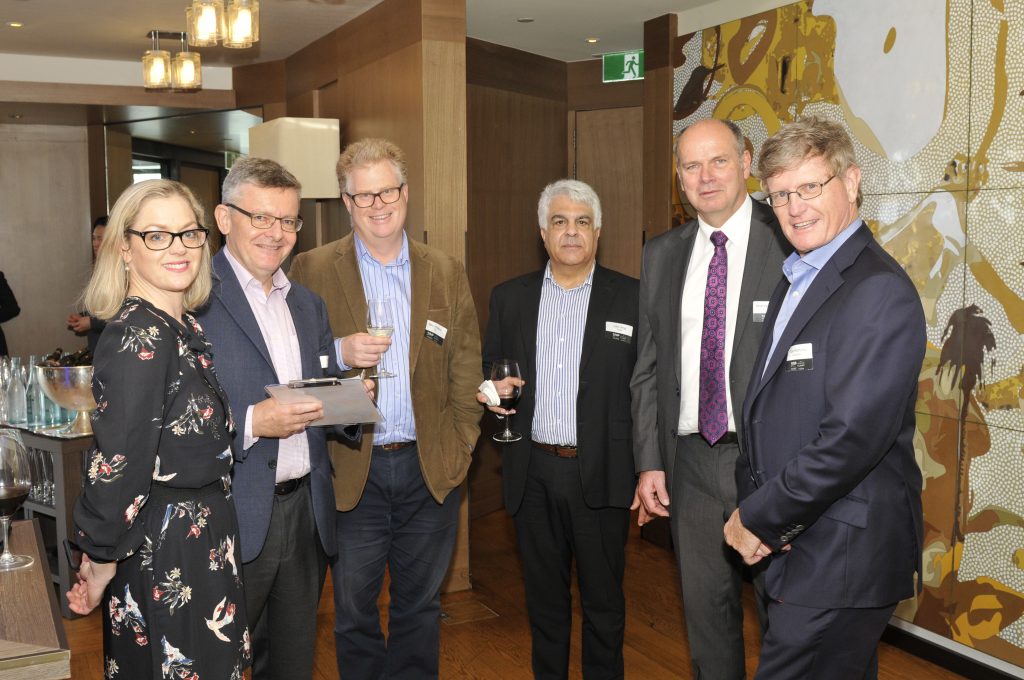 Colleagues and friends in conversation (from left): BAE Systems’ Kirsty Buchan; Paul Tuck from Airbus; Ben Waters of Presync; John King of True False Consulting; Air Commodore Andrew Elfverson, RAAF; and GE Aviation’s David Mahoney. Kirsty Buchan said of the partnership between GE and BAE Systems in maintaining the RAAF Hawk lead-in fighter jets: “We’ve been working together on the Hawk for around 20 years, “We’re all under the same roof at Williamtown, which has been really valuable in building the level of understanding we have together of what our customer, the RAAF, requires.”
Colleagues and friends in conversation (from left): BAE Systems’ Kirsty Buchan; Paul Tuck from Airbus; Ben Waters of Presync; John King of True False Consulting; Air Commodore Andrew Elfverson, RAAF; and GE Aviation’s David Mahoney. Kirsty Buchan said of the partnership between GE and BAE Systems in maintaining the RAAF Hawk lead-in fighter jets: “We’ve been working together on the Hawk for around 20 years, “We’re all under the same roof at Williamtown, which has been really valuable in building the level of understanding we have together of what our customer, the RAAF, requires.”Several attendees at GE Aviation’s centenary had spent their early careers in the RAAF, including Rambow who first served as an Avionics Systems Engineer on F/A-18 aircraft; former RAAF fighter pilot, Christian Boucousis, whose Australian Aviation magazine published the full story of GE Aviation in Australia; and former GE Aviation executive Tom Gleeson who took a break from his new role outside the company to MC the event.
Among Rambow’s thanks to airlines and industry partners such as BAE Systems and Safran, and financial partners such as GE Commercial Aviation Services and Nordic Aviation Capital, she echoed Joyce’s opening gambit and summed up the sentiment in the room when she thanked GE Aviation’s airframe partners:
“We have Boeing, Airbus, Embraer and Bombardier in the room, and for me ours is one of the most interesting business relationships you could ever have — sometimes we’re partners, sometimes we’re competitors, but we always have a lot of fun and we appreciate the friendships that we make along the way.”
